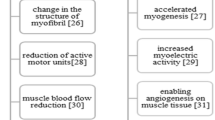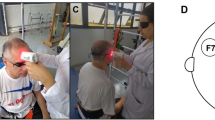Abstract
The cerebrovascular accident (CVA), high-impact disease II, affects the basic functions of the limbs, leading to changes of sensory, language, and motor functions. The search for resources that minimize the damage caused by this disease grows every day. The clinical use of low-intensity laser therapy (LILT) has provided major breakthroughs in the treatment of muscular disorders and prevention of muscle fatigue. Thus, the objective of the present study is to analyze the answers and immediate adaptations of the rectus femoris and vastus medialis of spastic hemiparetic patients, facing the increase in peak torque and triggering muscle fatigue, after application of LILT. Double-blind clinical trials were conducted with 15 volunteers post-CVA with spasticity, of both genders, between 40 and 80 years old. To this end, the volunteers went through three consecutive stages of rating (control, placebo, and laser). All performed tests of isometric contraction on the patient’s hemiparetic side. Significant differences were observed with regard to the increase in muscle performance (p = 0.0043) and the reduction in blood lactate concentration (p < 0.0001) of the post-LILT muscles. The LILT (diode laser, l100 mW 808 nm, 4.77 J/cm2/point, 40 s/AP) can be employed during and after spastic muscle-strengthening exercises, contributing to the improvement of motor function of the patient. After application of LILT, we found increased torque as well as decreased in lactate level in patients with spasticity.





Similar content being viewed by others
References
Radanovic M (2000) Características do atendimento de pacientes com acidente vascular cerebral em hospital secundário. Arq Neuropsiquiatr 58(1):99–106. doi:10.1590/S0004-282X2000000100015
Rowland LP (2002) Merrit: tratado de neurologia. Guanabara Koogan, Rio de Janeiro
Castro JC et al. (2008) Tratamiento quirúrgico de la espasticidad. Publishing Neurocirurgia Conteporânea.http://neurocirurgia.com/intervenciones/espasticidad/tratamientoquirurgicoespasticidad.pdf.Accessed in 27 August 2012.
O`sullivan SB, Schmitz TJ. (2010) Fisioterapia: avaliação e tratamento. Manole, São Paulo.
Correia ACS, Silva JDS, Silva LVC, Oliveira DA, Cabral ED (2010) Crioterapia e cinesioterapia no membro superior espástico no acidente vascular cerebral. Fisioter Mov 23(4):555–563. doi:10.1590/S0103-51502010000400006
Cardoso E, Pedreira G, Prazeres A, Ribeiro N, Melo A (2007) Does botulinum toxin improve the function of the patient with spasticity after stroke? Arq Neuropsiquiatr 65(3-A):592–595. doi:10.1590/S0004-282X2007000400008
Dietz V, Sinkjaer T (2007) Spastic movement disorder: impaired reflex function and altered muscle mechanics review. Lancet Neurol 6:725–773. doi:10.1016/S1474-4422
Porto CC (2008) Exame clínico: bases para a prática médica. Guanabara Koogan, Rio de Janeiro
Bensmail D, Robertson J, Fermanian C, Roby-Brami A (2010) Botulinum toxin to treat upper-limb spasticity in hemiparetic patients: analysis of function and kinematics of reaching movements. Neurorehabil Neural Repair 24(3):273–281. doi:10.1177/1545968309347683
Macko RF, Souza CA, Tretter BS, Silver KH, Smith GV, Andersen PA, Tomoyasu N, Gorman P, Dengel DR (1997) Treadmill aerobic exercise training reduces the energy expenditure and cardiovascular demands of hemiparetic gait in chronic stroke patients. Stroke 28(2):326–330. doi:10.1161/01.STR.28.2.326
Potempa KL, Braun L, Tinknell T, Popovich J (1996) Benefits of aerobic exercise after stroke. Sports Med 21:337–346. doi:10.2165/00007256-199621050-00003
Teixeira-Salmela LF, Nadeau S, Mcbride I, Olney SJ (2001) Effects of muscle strengthening and physical conditioning training on temporal, kinematic and kinetic variables during gait in chronic stroke survivors. J Rehabil Med 33(2):53–60
Robertson V et al (2009) Eletroterapia explicada: princípios e prática. Elsevier, São Paulo
Lopes-Martins RA, Marcos RL, Leonardo PS, Prianti AC Jr, Muscará MN, Aimbire F, Frigo L, Iversen VV, Bjordal JM (2006) Effect of low-level laser (Ga-Al-As 655 nm) on skeletal muscle fatigue induced by electrical stimulation in rats. J Appl Physiol 101(1):283–288. doi:10.1152/japplphysiol.01318.2005
Ferraresi C, de Brito OT, de Oliveira ZL, de Menezes Reiff RB, Baldissera V, de Andrade Perez SE, Matheucci Júnior E, Parizotto NA (2011) Effects of low level laser therapy (808) on physical strength training in humans. Lasers Med Sci 26:349–358. doi:10.1007/s10103-010-0855-0
Leal Junior EC, Lopes-Martins RA, Baroni BM, DeMarchi T, Taufer D, Manfro DS, RechM DV, Grosselli D, Generosi RA, Marcos RL, Ramos L, Bjordal JM (2009) Effect of 830 nm low-level laser therapy applied before high-intensity exercises on skeletal muscle recovery in athletes. Lasers Med Sci 24(6):857–863. doi:10.1007/533 s10103-008-0633-4
Baroni BM, Leal Junior EC, De Marchi T, Lopes AL, Salvador M, Vaz MA (2010) Low level laser therapy before eccentric exercise reduces muscle damage markers in humans. Europ J Appl Physiol 110(4):789–796. doi:10.1007/s00421-010-1562-z
Leal Junior EC, Lopes-Martins RA, Frigo L, De Marchi T, Rossi RP, de Godoi V, Tomazoni SS, da Silva DP, Basso M, Filho PL, de Valls CF, Iversen VV, Bjordal JM (2010) Effects of low level laser therapy (LILT) in the development of exercise-induced skeletal muscle fatigue and changes in biochemical markers related to post-exercise recovery. J Orthop Sport Phy Ther 40(8):524–532. doi:10.2519/jospt.2010.3294
de Almeida P, Lopes-Martins RA, De Marchi T, Tomazoni SS, Albertini R, Corrêa JC, Rossi RP, Machado GP, da Silva DP, Bjordal JM, Leal Junior EC (2012) Red (660 nm) and infrared (830 nm) low-level laser therapy in skeletal muscle fatigue in humans: what is better? Lasers Med Sci 27:453–458. doi:10.1007/s10103-011-0957-3
De Marchi T, Leal Junior EC, Bortoli C, Tomazoni SS, Lopes-Martins RA, Salvador M (2012) Low-level laser therapy (LILT) in human progressive-intensity running: effects on exercise performance, skeletal muscle status, and oxidative stress. Lasers Med Sci 27:231–236. doi:10.1007/s10103-011-0955-5
Vieira WH, Ferraresi C, Perez SE, Baldissera V, Parizotto NA (2012) Effects of low-level laser therapy (808 nm) on isokinetic muscle performance of young women submitted to endurance training: a randomized controlled clinical trial. Lasers Med Sci 27:497–504. doi:10.1007/s10103-011-0984-0
Patrocinio T, Sardim AC, Assis L, Fernandes KR, Rodrigues N, Renno AC (2013) Effect of low-level laser therapy (808 nm) in skeletal muscle after resistance exercise training in rats. Photomed Laser Surg 31(10):492–498. doi:10.1089/pho.2013.3540
Toma RL, Tucci HT, Antunes HK, Pedroni CR, de Oliveira AS, Buck I, Ferreira PD, Vassão PG, Renno AC (2013) Effect of 808 nm low-level laser therapy in exercise-induced skeletal muscle fatigue in elderly women. Lasers Med Sci 28:1375–1382. doi:10.1007/s10103-012-1246-5
Romero JR, Morris J, Pikula A (2008) Review: stroke precention: modififying risk factors. Therap Adv Card Disease 2(4):287–303. doi:10.1177/1753944708093847
Leal Junior EC, Lopes-Martins RA, Frigo L, De Marchi T, Rossi RP, de Godoi V, Tomazoni SS, Silva DP, Basso M, Filho PL, de Valls Corsetti F, Iversen VV, Bjordal JM (2011) Effects of low-level laser therapy (LILT) in development of exercise-induced skeletal muscle fatigue and changes in biochemical markers related to post exercise recovery. J Orthop Sport Phy Ther 40(8):524–532. doi:10.1007/s10103-0131465-4
Alves I, Tedim Cruz V, Grebe HP (2013) Spasticity as the first manifestation of ischaemic lesions involving the cingulum. Case Rep Neurol Med. 2013:534243. doi:10.1155/2013/534243
Urban PP, Wolf T, Uebele M, Marx JJ, Vogt T, Stoeter P, Bauermann T, Weibrich C, Vucurevic GD, Schneider A, Wissel J (2010) Occurrence and clinical predictors of spasticity after ischemic stroke. Stroke 41(9):2016–2020. doi:10.1161/STROKEAHA.110.581991
Lodha N, Naik SK, Coombes SA, Cauraugh JH (2010) Force control and degree of motor impairments in chronic stroke. Clin Neurophysiol 121:1952–1961. doi:10.1016/j.clinph.210.04.005
Chang SH, Francisco GE, Zhou P, Rymer WZ, Li S (2013) Spasticity, weakness, force variability and sustained spontaneous motor unit discharges of resting spastic-paretic biceps brachii muscles in chronic stroke. Muscle Nerve 48(1):85–92. doi:10.1002/mus.23699
Zivin JA, Albers GW, Bornstein N et al (2009) Effectiveness and safety of transcranial laser therapy for acute ischemic stroke. Stroke 40(4):1359–1364. doi:10.1161/STROKEAHA.109.547547
Xuan W, Vatansever F, Huang L, Wu Q, Xuan Y, Dai T, Ando T, Xu T, Huang YY, Hamblin MR (2013) Transcranial low-level laser therapy improves neurological performance in traumatic brain injury in mice: effect of treatment repetition regimen. PLoS One 8(1):e53454. doi:10.1371/journal.pone.0053454
Lindberg PG, Gäverth J, Fagergren A, Fransson P, Forssberg H, Borg J (2009) Cortical activity in relation to velocity dependent movement resistance in the flexor muscles of the hand after stroke. Neurorehabil Neural Repair 23(8):800–810
Ascensão J, Magalhaes J, Oliveira J, Duarte J (2003) Muscular fatigue: definition models of study and mechanisms of central and peripheral fatigue. Rev Port Ciên Desp 3(1):108–123
Ferraresi C, Hamblin MR, Parizotto NA (2012) Low-level laser (light) therapy (LILT) on muscle tissue: performance, fatigue and repair benefited by the power of light. Photonics Lasers Med 1(4):267–286. doi:10.1515/plm-2012-0032
Allen DG, Lamb GD, Westerblad H (2008) Skeletal muscle fatigue: cellular mechanisms. Physiol Rev 88(1):287–332. doi:10.1152/00015.2007
Westerblad H, Allen DG (2011) Emerging roles of ROS/RNS in muscle function and fatigue. Antioxid Redox Signal 15(9):2487–2499. doi:10.1089/ars.2011.3909
Oliveira P, Ribeiro SML (2010) Effects of carbohydrate intake on indicators of fatigue in group of adolescent futsal soccer players. Rev Bras Fisioter 1(1):64–68
Kelencz CA, Muñoz IS, Amorim CF, Nicolau RA (2010) Effect of low-power gallium-aluminum-arsenium noncoherent light (640 nm) on muscle activity: a clinical study. Photomed Laser Surg 28(5):647–652. doi:10.1089/pho.2008.2467
Karu TI, Pyatibrat LV, Afanasyeva NI (2005) Cellular effects of low power laser therapy can be mediates by nitric oxide. Lasers Surg Med 36(4):302–314. doi:10.1002/lsm.20148
Rizzi CF, Mauriz JL, Freitas Corrêa DS, Moreira AJ, Zettler CG, Filippin LI, Marroni NP, González-Gallego J (2006) Effects of low-level laser therapy (LILT) on the nuclear factor (NF)-kappaB signaling pathway in traumatized muscle. Lasers Med Scie 38(7):704–713
Xu X, Zhao X, Liu TC, Pan H (2008) Low-intensity laser irradiation improves the mitochondrial dysfunction of C2C12 induced by electrical stimulation. Photomed Laser Surg 26(3):197–202
Mirbagheri MM, Settle K, Harvey R, Rymer WZ (2007) Neuromuscular abnormalities associate with spasticity of upper extremity muscles in hemiparetic stroke. J Neurophysiol 98:629–637
Chang SH, Francisco GE, Zhou P, Rymer WZ, Li S (2013) Spasticity, weakness, force variability and sustained spontaneous motor unit discharges of resting spastic-paretic biceps brachii muscles in chronic stroke. Muscle Nerve 48(1):85–92
Tullberg M, Alstergren PJ, Ernberg MM (2003) Effects of low-power laser exposure on masseter muscle pain and microcirculation. Pain 105(1–2):89–96
Leal Junior EC, Lopes-Martins RA, Dalan F, Ferrari M, Sbabo FM et al (2008) Effect of 655-nm low-level laser therapy on exercise-induced skeletal muscle fatigue in humans. Photomed Laser Surg 26:419–424. doi:10.1089/pho.2007.2160
Friedman H, Lubart R (1993) Nonlinear photobiostimulation: the mechanisms of visible and infrared laser-induced stimulation and reduction of neural excitability and growth. Laser Therapy 5(1):30–42
Acknowledgments
The authors would like to thank Coordenação de Aperfeiçoamento Pessoal de Nível Superior (CAPES) for the financial support (PE 030/2008).
Ethical standards
This research was carried out in accordance with the current Brazilian laws relating to experiments in humans.
Conflict of interest
The authors declare that they have no conflicts of interest.
Author information
Authors and Affiliations
Corresponding author
Rights and permissions
About this article
Cite this article
dos Reis, M.C.R., de Andrade, E.A.F., Borges, A.C.L. et al. Immediate effects of low-intensity laser (808 nm) on fatigue and strength of spastic muscle. Lasers Med Sci 30, 1089–1096 (2015). https://doi.org/10.1007/s10103-014-1702-5
Received:
Accepted:
Published:
Issue Date:
DOI: https://doi.org/10.1007/s10103-014-1702-5




